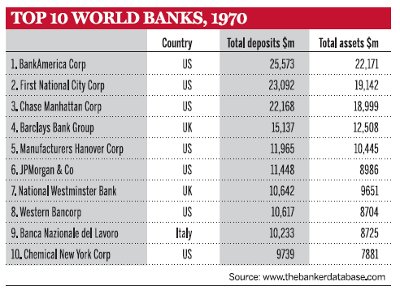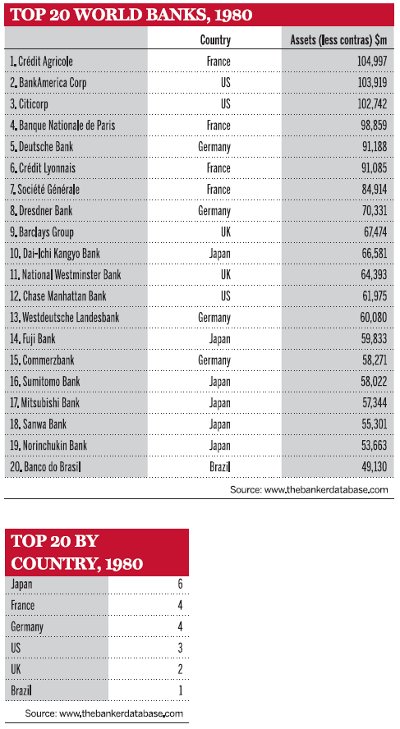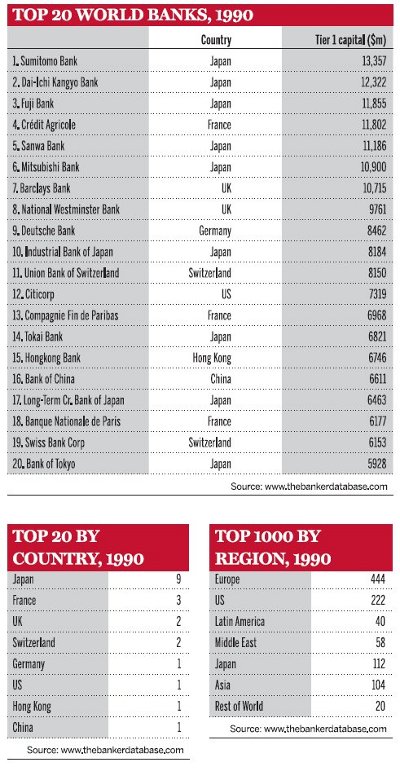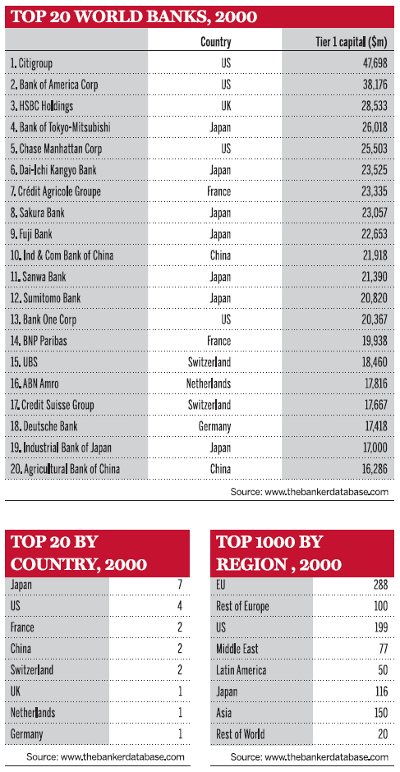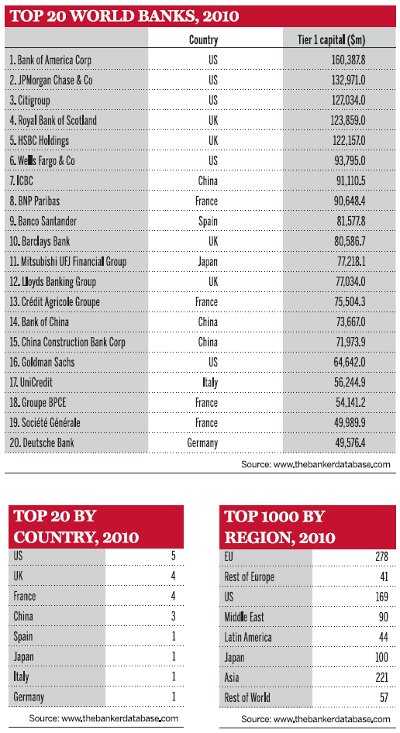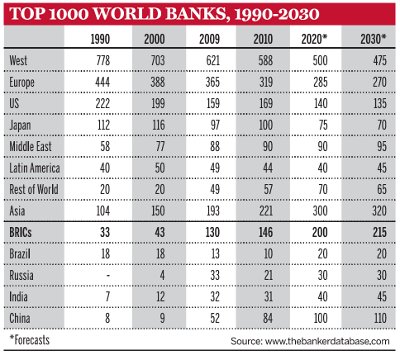Forty years after BankAmerica topped The Banker's first global bank rankings in 1970, the US-based bank has once again taken the number one spot in 2010. While Bank of America, JPMorgan and Barclays all participated in 1970 and 2010, this 40th anniversary of the listings shows that much else has changed in the sector. The Banker's editor emeritus Stephen Timewell reports.
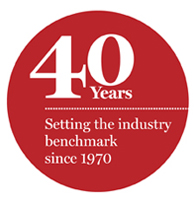
As the general consensus is that recovery is now under way, however fragile that may be, this article seeks to provide an historical perspective on how banking has evolved to where it is today, looking at the trends, the new world order that is emerging and where banking is likely to be in 2020 and on to 2030.
As the tables show, the past 40 years have witnessed enormous change in the banking sector and in financial institutions across the globe. Looking at The Banker's Top 1000 World Banks listings over this period provides an extraordinary view of not only the financial behemoths of the day but also the economies that produced them. If ever there was any doubt as to the direct correlation between the strength of a country's economy and of its banking system, the Top 1000 listings demonstrate admirably both the rise and fall of individual institutions and their core interrelationships with the economies from which they emerge.
Over time, banks reflect the state of their economies and, likewise, economies reveal the effectiveness or not of their banking sectors. This is not an argument for Keynesian solutions but an attempt to measure the developments of banks against their economies and assess how they have evolved and are likely to emerge in the future.
The bigger picture
To set the scene, it is worth looking at how the international economy and the banking industry worked in the past:
- In 1973, a developed world consisting of the US, western Europe and Japan, together with some offshoots such as Australia, was dominant. Known as 'the West', these countries accounted for 57.8% of global gross domestic product (GDP) but only 18.4% of the world's population.
- By 2001, the share of global GDP accounted for by 'the West' had fallen to 52% while its share of the world's population had declined to 14%.
- Asia's share of global GDP, excluding Japan, had increased from 16.4% in 1973 to 30.9% in 2001, while its share of the population had risen from 54.6% in 1973 to 57.4% in 2001.
These basic figures indicate the core discrepancy between the world's wealth and its population. This has been a core issue throughout history but in this new era, since the fall of the Berlin Wall in 1989, the end of the Cold War and the demise of the Soviet Union, there has been much change. Not only has the bipolar world of the West and the Soviet Union altered, so too have underlying assumptions about the superiority of the West.
Challenging beliefs
The belief that the West ultimately knows best is now being challenged. An era built around multiple sources is emerging and the West's dominance is receding as Asia, and particularly China, take up the challenge.
Looking at this big picture from an historical banking perspective shows how the sector has changed over the past 20 years and indicates possible trends for the future.
First, it is important to look at The Banker's Top 1000 World Banks in 1990 and see how the key players and dominant countries have changed in 2000 and 2010. The listings over this 20-year period for the three years used is based around the same methodology: the level of Tier 1 capital of the Top 1000 global banks. Before that, the ranking was based on assets so comparisons are difficult to make.
In 1990, the Top 1000 was dominated by Japan. Six of the Top 10 were Japanese banks, with Sumitomo Bank heading the list, followed by Dai-Ichi Kangyo Bank and Fuji Bank. The interesting aspect about the Top 20 global banks in 1990 was that, besides three French banks and two each from Switzerland and the UK, Japan dominated with nine banks. The region's economy was booming at that time and Japanese institutions were at their peak.
Examining the overall 1990 Top 1000 listing, banks from the West were omnipresent, accounting for almost 80% of overall capital and 80% of the Top 1000. Led by Europe with 444 banks, the US with 222 and Japan with 112, the Western bloc accounted for 778 banks (800 banks the previous year) in the listing with Asia (excluding Japan) accounting for just 93.
By 2000, as the figures show, different patterns were emerging, with US banks asserting themselves in the Top 20 and new trends developing in the Top 1000. US-based Citigroup and BankAmerica Corporation headed the leading banks and US banks in the Top 20 doubled to four. Meanwhile, the Japanese influence slipped to seven, and China, France and Switzerland each had two.
Global shift
The global picture in 2000 was shifting as the role of the Western banks declined significantly. Just as the number of US banks in the Top 1000 fell from 222 (in 1990) to 199, the number of European banks dropped sharply from 444 to 388, made up of 288 EU banks and 100 from the rest of Europe. Japanese banks, meanwhile, rose slightly to 116, bringing the Western total to 703, compared to 778 a decade previously - a 9% decline. However, Asian banks (excluding Japan) were expanding, rising to 150 (from 104 in 1990). Meanwhile, the banks from the BRIC countries (Brazil, Russia, India and China) were slowly increasing from 33 in 1990 to 43 in 2000, with much more to come.
Asian banks rose to 193 in 2009, a 32.2% increase over 146 a decade earlier, much of this explained by the inclusion of 52 Chinese banks in 2009, up from seven a decade earlier.
In The Banker's 2010 Top 1000, the US and UK banks head the listing with Bank of America Corp on top. Next come JPMorgan Chase & Co and Citigroup, followed by two UK banks, Royal Bank of Scotland and HSBC Holdings. Of the Top 20 banks, five are from the US, four from the UK, four from France and three from China.
In 2010, the Top 1000 ranking reflects both the continuing decline in the banks of the West and the rise of the banks in Asia, particularly those in China. From 703 banks in 2000, the West (Europe, Japan and the US) has slipped to 588 in the 2010 listing, while Asia's banks have jumped from 150 in 2000 to 221 in 2010, almost a 50% increase, with the number of Chinese banks rising from a modest nine in 2000 to a huge 84 in 2010.
The composite figure paints a very clear picture in relation to banking trends in the West, Asia and the emerging BRIC economies.
The key conclusions are:
- The banks from the Western bloc are in terminal decline as the downward trend from 778 banks in 1990's Top 1000 to 703 in 2000, and 621 in 2009's Top 1000 to 588 in 2010 would suggest.
- Asian banks are expanding rapidly on the world stage, rising from 104 in 1990 to 150 in 2000, 193 in 2009 and 221 in 2010.
- Chinese banks, with 52 in the 2009 Top 1000 (up from eight in 1989) and 84 in 2010, are a growing banking force as China's economy has already become the third largest in the world.
- The BRICs are on a solid growth path, with their combined banks rising from 43 in the 1989 Top 1000 listing to 130 in the 2009 listing and 146 in 2010.
In short, a new world order in banking is emerging, with the traditional dominant players in the post-Second World War period, the Western banks, no longer playing the role they once did. Just as banks in Asia and the other BRIC states are on the rise, other regions are also growing and providing significant banking institutions. The oil-rich Middle East had 88 banks in the 2009 listing and 90 in the 2010 listing , up from 58 in 1990, and with the rapid growth of Islamic finance, banks from this region are on an upward path.
Likewise, in an increasingly globalised world other areas are expanding their influence. While Latin American banks decreased to 44 in 2010, down from 50 in 2000, banks from the rest of the world, such as Kazakhstan, Nigeria and South Africa, have an increasing role to play with the rest of the world, accounting for 57 banks in 2010 compared to 20 in 2000. The financial balance in the world is shifting.
Financial forecast
When considering what The Banker's 2020 Top 1000 listing will look like, it is worth examining some population and growth forecasts from multilateral institutions. The world's structure will look quite different as the developing countries of the past are expected to move ahead and overtake today's developed world in some respects.
Credible forecasts suggest:
- By 2032, the share of global GDP of the BRICs will exceed that of the G7 (namely Canada, France, Germany, Italy, Japan, the UK and the US).
- Asia's population will remain about 60% of the global total.
- India and China combined had a 37.3% share of the world's population in 2001 and this is projected to fall very slightly. Meanwhile, the population of the developed world will continue to fall steadily.
In light of some of these forecasts and the impact of the recent global financial crisis, what could the financial world look like in 2020 and further ahead in 2030?
In 2020, the current crisis could not only have had a significant impact but the already existing trend of going east to Asia' will have accelerated and become even more emphasised.
Before looking at estimates for 2020, it is useful to examine the possible consequences of the current crisis. The credit crunch has clearly demonstrated the inadequacies of the current systems and the bubbles that have emerged have been blamed on regulators, governments, greed, bonuses and just about everything else. And just as the recent fiasco over Dubai's debt standstill and the Greek crisis have been described as a mess, the global financial crisis is a huge problem with few easy solutions.
The International Monetary Fund noted recently that public sector gross debt is expected to explode from an average across advanced economies of 78% of national income in 2007 to 118% in 2014. The deficits and debt, the structural impact of reduced tax revenues and rising unemployment cannot be swept under the carpet. The advanced countries are in for a painful time and will suffer.
The crisis caused damage to emerging economies and the BRIC countries too but, because they were less exposed and their economies are less leveraged than those in the West, they have less debt and with their high-growth strategies they have more cause for optimism.
The crisis has accelerated the new world order in a number of ways and will continue to do so. The West will continue to decline, probably at a faster rate. Helped to some extent by lesser damage in the crisis, the emerging economies will become stronger in a multiple-source world. The global financial world will not be dominated by the US and western Europe as in the past but will have more sources of power and a larger number of serious players. The global game is changing significantly and the new world order represents a massive shift in structure.
So what will The Banker's listing in 2020 look like? No forecasts are certain but it can be argued that the 21st century's second decade will provide more demonstrative change than the first with important shifts both at the top of the table and in the overall structure.
Many of the banks in the Top 20 in 2020 will have been in the Top 20 in 2010 but the dominance of Western banks will be in decline. The West had 17 in the 2009 Top 20 and 17 in the 2010 Top 20 but, based on conservative assumptions, this is likely to fall to 14 or less with US banks still leading the charge. Although Japan had seven banks in the Top 20 in 2000, this fell to three in 2009 and just one in 2010. It is likely to drop below that as Japan's economy and financial strength continues to slide. Alternatively, banks such as Agricultural Bank of China, Brazil's Itau and Bradesco and Russia's Sberbank are likely to be pushing for Top 20 spots.
Looking East
The 2020 Top 1000 forecast represents a significant shift from West to East with strong growth expected in Asia (including China) and a continuing decline in the Western-bloc banks. These core assumptions indicate that the West's share of the Top 1000 will fall to about 500, compared with nearly 80% of it in 1990. Asian banks will accelerate their influence, providing a forecast 300 banks in 2020, almost more than three times that of 1990. China's banks could be expected to reach at least 100 with the BRIC bank total forecast conservatively to reach 200.
Looking at the 2030 Top 1000, it is difficult to add much new thinking except that India's banks may expand further and, again, the Asian expansion will continue. By 2030, the West's number of banks could be seen to decrease to 450 while Asia will continue to grow, reaching 350 banks and providing much more of a balance between the two regions.
The key conclusion is that Western banks as we know them are in serious decline and this century looks like the turn of Asia, and of China in particular.



